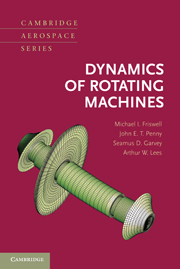Book contents
- Frontmatter
- Contents
- Preface
- Acronyms
- 1 Introduction
- 2 Introduction to Vibration Analysis
- 3 Free Lateral Response of Simple Rotor Models
- 4 Finite Element Modeling
- 5 Free Lateral Response of Complex Systems
- 6 Forced Lateral Response and Critical Speeds
- 7 Asymmetric Rotors and Other Sources of Instability
- 8 Balancing
- 9 Axial and Torsional Vibration
- 10 More Complex Rotordynamic Models
- Solutions to Problems
- Appendix 1 Properties of Solids
- Appendix 2 Stiffness and Mass Coefficients for Certain Beam Systems
- Appendix 3 Torsional Constants for Shaft Sections
- Bibliography
- Index
6 - Forced Lateral Response and Critical Speeds
Published online by Cambridge University Press: 05 February 2015
- Frontmatter
- Contents
- Preface
- Acronyms
- 1 Introduction
- 2 Introduction to Vibration Analysis
- 3 Free Lateral Response of Simple Rotor Models
- 4 Finite Element Modeling
- 5 Free Lateral Response of Complex Systems
- 6 Forced Lateral Response and Critical Speeds
- 7 Asymmetric Rotors and Other Sources of Instability
- 8 Balancing
- 9 Axial and Torsional Vibration
- 10 More Complex Rotordynamic Models
- Solutions to Problems
- Appendix 1 Properties of Solids
- Appendix 2 Stiffness and Mass Coefficients for Certain Beam Systems
- Appendix 3 Torsional Constants for Shaft Sections
- Bibliography
- Index
Summary
Introduction
In Chapters 3 and 5, methods are presented to determine the dynamic characteristics of a rotor–bearing system, such as the natural frequencies, damping factors, and mode shapes. In this chapter, we examine how rotor–bearing systems respond to forces and moments. The most common forces acting in rotating machines are lateral forces and moments whose frequencies are locked to the rotor speed or multiples of rotor speed. A force whose frequency is identical to rotor speed is said to be a synchronous force. We also examine how rotor–bearing systems respond to forces the frequency of which is unrelated to rotor speed, called asynchronous forces – for example, external forces acting on the rotor via the bearings and foundation.
The most significant lateral forces and moments are usually caused by an imperfect distribution of mass in the rotor. As the rotor spins about its equilibrium position, forces and moments are generated that are called out-of-balance forces and moments. The direction of these forces and moments is fixed relative to the rotor; therefore, their direction rotates with the rotor. Thus, the excitation frequency in any plane, lateral to the axis of the rotor, is locked to the speed of rotation; for this reason, they are synchronous forces and moments. Due to manufacturing tolerances and other factors, it is not possible to ensure that rotors are perfectly balanced. Although when new or recently commissioned, a rotor is balanced so that the residual out-of-balance is minimal, this out-of-balance may increase with the passage of time. For example, in a gas turbine, blades may become unevenly fouled or unevenly eroded, which may lead to an increase in residual out-of balance.
- Type
- Chapter
- Information
- Dynamics of Rotating Machines , pp. 228 - 295Publisher: Cambridge University PressPrint publication year: 2010

